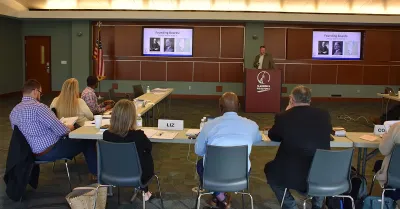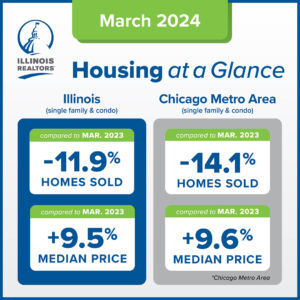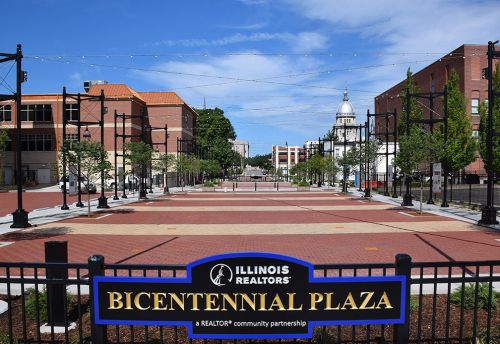Legal Case Studies: Takings Clause
Legal case studies this issue:
- U.S. Supreme Court takes extraordinary action in overruling a 1985 takings case that limited property owner’s right to sue in federal court.
- Subsequent purchasers of lots in unfinished development could be liable to finish improvements required under annexation agreement.
- Chicago homeowner alleging risk of lead poisoning from water main replacement stated a cause of action for negligence and inverse condemnation against city.
- After bridge closure, owners of country property did not retain an easement over road that provided most convenience access.
- Plaintiff did not have standing to sue concrete subcontractor for faulty work.
Research and analysis by Lisa Harms Hartzler,
Sorling Northrup Attorneys
U.S. Supreme Court takes extraordinary action in overruling a 1985 takings case that limited property owner’s right to sue in federal court.
In Knick v. Township of Scott, Pennsylvania, 139 S.Ct. 2162 (2019), the U.S. Supreme Court overturned a long-standing case affecting when a property owner may sue the government under the Fifth Amendment’s Takings Clause. The Takings Clause provides that “private property [shall not] be taken for public use, without just compensation.” In the 1985 case of Williamson County Regional Planning Commission v. Hamilton Bank of Johnson City, the Supreme Court held that a property owner whose property has been taken by a local government has not suffered a violation of his Fifth Amendment rights—and therefore cannot bring a federal takings claim in federal court—until a state court has denied his claim for just compensation under state law, i.e., the plaintiff must exhaust available state remedies first.
Although the Williamson decision anticipated that a property owner who failed to secure just compensation in state court would then have a “ripe” claim that could be pursued in federal court, the decision actually created a Catch-22 for a plaintiff. A state court’s resolution of a claim for just compensation under state law has a “preclusive” effect in any subsequent federal suit. Consequently, if a plaintiff loses in state court, a federal court cannot re-litigate the same issue. But if a plaintiff does not obtain a judgment in state court first, he or she cannot bring an action in federal court because all state remedies have not been exhausted.
The Court overturned Williamson, concluding that “the state-litigation requirement imposes an unjustifiable burden on takings plaintiffs, conflicts with the rest of our takings jurisprudence, and must be overruled.”
In Knick, a township passed an ordinance requiring all cemeteries to be kept open and accessible to the general public during daylight hours. In 2013 a township officer found several grave markers on Knick’s property and notified her that she was in violation of the ordinance by failing to open the cemetery to the public during the day. Knick sued the township in state court for a declaratory judgment, claiming the ordinance effected a taking of her property.
The township withdrew its violation notice pending the outcome of the case. However, without a pending enforcement action and a demonstration of irreparable harm, the state court declined to rule. Knick then sued in federal court under Section 1983, alleging a Takings Clause violation. The federal district court, under Williamson, dismissed Knick’s takings claim because she had not pursued an inverse condemnation action in state court. The Third Circuit Court of Appeals affirmed the dismissal.
The Williamson decision had been long been criticized as relegating the Takings Clause “to the status of a poor relation” among the provisions of the Bill of Rights. The Supreme Court in Knick declared that its decision restored “takings claims to the full-fledged constitutional status the Framers envisioned when they included the Clause among the other protections in the Bill of Rights.”
In overruling Williamson, the Court admitted that the case “was not just wrong. Its reasoning was exceptionally ill founded and conflicted with much of our takings jurisprudence.” It concluded that “a government violates the Takings Clause when it takes property without compensation, and that a property owner may bring a Fifth Amendment claim under §1983 at that time.”
Subsequent purchasers of lots in unfinished development could be liable to finish improvements required under annexation agreement.
In United City of Yorkville v. Fidelity and Deposit Company of Maryland, 2019 IL App (2d) 180230, the appellate court drew a distinction from the facts in a case reported in the Legal Case Studies for September, 2018. That case, Doyle v. Village of Tinley Park, decided by the First District Appellate Court, held plaintiff homeowners who purchased houses from a developer did not have standing to sue the developer for structural damage caused by a failure to provide adequate storm sewers as required in an annexation agreement between the homeowners and the village. The court found that the annexation agreement’s binding nature on successors and assigns of “the subject property,” applied when those successors and assigns purchased the entire property, not individual lots. The court explained, had the agreement intended to extend to individual lot owners, it would have said it was binding on successors of the subject property or any part thereof.
The Yorkville case decided by the Second District presented just such a situation. The City entered into an annexation agreement with a developer (KH) who went bankrupt and filed for liquidation prior to completing all of the required infrastructure for a 300-acre development called Whispering Meadows. Before and during the bankruptcy proceedings, two builders purchased lots from KH but refused to complete the public improvements, arguing that they purchased the lots as individual owners, not developers of the entire plot, and had no obligation to the City. The City sued the two developer-builders, along with KH’s surety bond provider, Fidelity.
The court looked at the annexation agreement, which “referred to the rights and duties of the developer and all successor developers of the property or any parcel or phase thereof.” The court interpreted this section as providing that the property could be conveyed to a successor developer in whole or in part. Combined with another section of the agreement, which placed no restriction on the number of successor developers at any given time, the court concluded that the annexation agreement allowed for multiple developers and proportional liability for development duties.
The court also distinguished Doyle by noting the difference between someone who purchases a lot to have a home constructed on it and a party who purchases lots in order to construct homes for third-party buyers. It might be unfair to impose infrastructure obligations on the first type of buyer but, according to the court, “it would be eminently fair to impose those obligations upon the second type” even though they have not purchased the entirety of the development subject to the annexation agreement. The court reversed the trial court’s decision to dismiss the City’s complaint and remanded it for further proceedings.
Chicago homeowner alleging risk of lead poisoning from water main replacement stated a cause of action for negligence and inverse condemnation against city.
In Berry v. City of Chicago, 2019 IL App (1st) 180871, a trial court dismissed plaintiffs’ class action complaint alleging negligence and inverse condemnation against the City of Chicago when the city replaced the water main and/or water meter connected to their homes. On appeal, the appellate court reversed the dismissal.
The complaint alleged the City owed the plaintiffs a duty to exercise reasonable care in providing safe drinking water, free from well-documented and dangerous contaminants such as lead that would expose them to unnecessary health risks, including various ailments like neuropathy, motor nerve dysfunction, weakened immunity to disease, renal failure, gout, hypertension, muscle and joint pain, memory and concentration problems, and infertility. The effect of lead in the body is even far more problematic in children. The court noted that “nearly 80 percent of the properties in Chicago receive their drinking water via lead pipes.” The City minimized the risk of lead contamination by using a chemical in the water supply that coats the interior of water mains and plumbing from flaking or dislodged lead, but such protection can fail when construction or street work, water and sewer main replacement, meter installation or replacement, or plumbing repairs cause the coating to flake off. The problem is exacerbated when copper replacements are connected to residences still using lead service pipes. Unsafe lead levels can persist for weeks or months after a disturbance.
The plaintiffs contended that the City failed to exercise reasonable care in providing safe drinking water by failing to warn or protect plaintiffs from lead exposure when it replaced the water main and/or water meter connected to their homes and, as a result, caused plaintiffs damages and increased risk of harm. The trial court found that plaintiffs did not allege present physical injuries or show damage to their water service lines. It also found that an inverse condemnation claim required an allegation of special damage to property in excess of that sustained by the public generally.
The appellate court disagreed (although one justice filed a strong dissent). It held that in a case alleging negligence, an injury is defined as “an invasion of a person’s interest, even if there is no immediate harm or that harm is speculative.” At the complaint stage of the litigation, the trial court should have accepted the plaintiffs’ allegations that “replacing the water mains and meters caused a high level of a dangerous contaminant, lead, to leach in to their water and that they drank the contaminant, thus exposing their bodies, and the organs, tissues, and bones therein, to lead” that can remain in a person’s body for many years before an illness develops. Thus, the appellate court found that plaintiffs sufficiently alleged a present injury in consuming lead-contaminated water, even if they had yet to develop physical ailments linked to such consumption.
With regard to the inverse condemnation claim the appellate court also found that plaintiffs had sufficiently alleged the required special damages “beyond that experienced by the public generally” by claiming the City further damaged their property by only partially replacing lead service lines when reconnecting water service to the newly replaced water mains, making them “more dangerous” than lines that were not partially replaced or were not made of lead. The case was remanded back to the trial court for continued proceedings.
After bridge closure, owners of country property did not retain an easement over road that provided most convenience access.
In Hess v. Miller, 2019 IL App (4th) 180591, a drainage and levee district closed a bridge traversing a levee shortly after plaintiffs purchased property containing their residence in the countryside. The plaintiffs had two ways to access their property: (1) access from the west by way of road crossing the levee and quickly leading to a blacktop road (the “Blacktop Road Access”) and (2) access from the east by way of several gravel township roads eventually leading to a highway (the “Gravel Road Access”). Plaintiffs contended the Blacktop Road Access was the most efficient and safest route to reach Quincy, Illinois, for medical, shopping and other needs within 20 minutes. They argued that the Gravel Access Road took 35 minutes to reach Quincy and was dusty, less safe and a longer drive. By closing the bridge over the levee, the Blacktop Road Access was eliminated.
Plaintiffs contended that when closing the bridge effectively closed the road, they retained an easement under a 1975 Illinois Supreme Court case holding that abutting property owners of a vacated street in a platted subdivision retained an easement over the vacated street. The appellate court, however, said that the case was inapplicable in this situation because no subdivision plat was involved in this case. “The existence of a subdivision plat is legally significant because the sale and conveyance of lots according to a published plat implies a grant or covenant to the purchaser that streets, alleys and other public places indicated as such upon the plat shall be forever open to the use of the public.”
The court held that, since plaintiffs did not retain an easement under the law when the bridge was vacated, they could only obtain one by a grant, by implication, or by prescription. In this case there was no express grant and no prescription, since prescription requires 20 years of use that is “adverse, uninterrupted, exclusive, continuous, and under a claim of right.” There was also no easement by implication because that easement arises only when it is essential to the beneficial enjoyment of the land. If there are available alternatives affording reasonable means of ingress and egress, no easement by implication will arise. Alternative access need only be reasonable; it does not have to be the best, the quickest, or the safest.
The court concluded that plaintiffs in this case had reasonable alternative means to reach their property via the Gravel Road Access. The trial court’s order granting them an easement was reversed.
Plaintiff did not have standing to sue concrete subcontractor for faulty work.
In Goldfarb v. Bautista Concrete, Inc., 2019 IL App (1st) 172968, an Illinois appellate court extended a 2018 Illinois Supreme Court holding that the implied warranty of habitability is a “creature of contract” that cannot be asserted by the purchaser of a home against a subcontractor without a contractual relationship between the property owner and the subcontractor. In this case, the plaintiff, “Junior,” contended that his father, “Senior,” purchased the property and took out a $1 million loan for construction. However, Junior was to make the loan payments as he was the intended occupant and future owner. Junior and Senior agreed to split the costs of construction above the loan amount equally, which they expected to be around $150,000. Junior’s complaint alleged that the defendant subcontractor’s faulty concrete work required him spend at least $412,000 additional in repairs.
The defendant subcontractor filed a motion for summary judgment, arguing that the plaintiff, Junior, could not maintain a cause of action for breach of implied warranty of good workmanship because Senior was the legal property owner and no written or oral contract between the plaintiff and the defendant existed. The court agreed with the defendant. Junior did not have standing to sue the subcontractor. It was irrelevant whether the contractor was insolvent, whether Junior was the current occupant, or whether Senior intended to transfer the property to Junior in the future. Junior never contracted with the subcontractor, “which our supreme court has now clarified is a prerequisite for a breach of implied warranty of habitability claim. Additionally, it is reasonable to extend that reasoning to the claim for breach of the implied warranty of good workmanship, which applies to workmanship issues in construction contracts.”
The appellate court affirmed the trial court’s dismissal of Junior’s complaint for lack of standing.
About the writer: Lisa Harms Hartzler is Of Counsel at Sorling Northrup Attorneys in Springfield. She graduated from the American University Washington College of Law in 1978 and began her legal career in Chicago. She has provided legal support for the Illinois REALTORS’ local governmental affairs program since she joined Sorling in 2006 and focuses her practice on municipal law, general corporate issues, not-for-profit health care law, and litigation support.





 Create professional development programs that help REALTORS® strengthen their businesses.
Create professional development programs that help REALTORS® strengthen their businesses.
 Protect private property rights and promote the value of REALTORS®.
Protect private property rights and promote the value of REALTORS®.
 Advance ethics enforcement programs that increase REALTOR® professionalism.
Advance ethics enforcement programs that increase REALTOR® professionalism.
 Protect REALTORS® by providing legal guidance and education.
Protect REALTORS® by providing legal guidance and education. Stay current on industry issues with daily news from Illinois REALTORS®, network with other professionals, attend a seminar, and keep up with industry trends through events throughout the year.
Stay current on industry issues with daily news from Illinois REALTORS®, network with other professionals, attend a seminar, and keep up with industry trends through events throughout the year.


